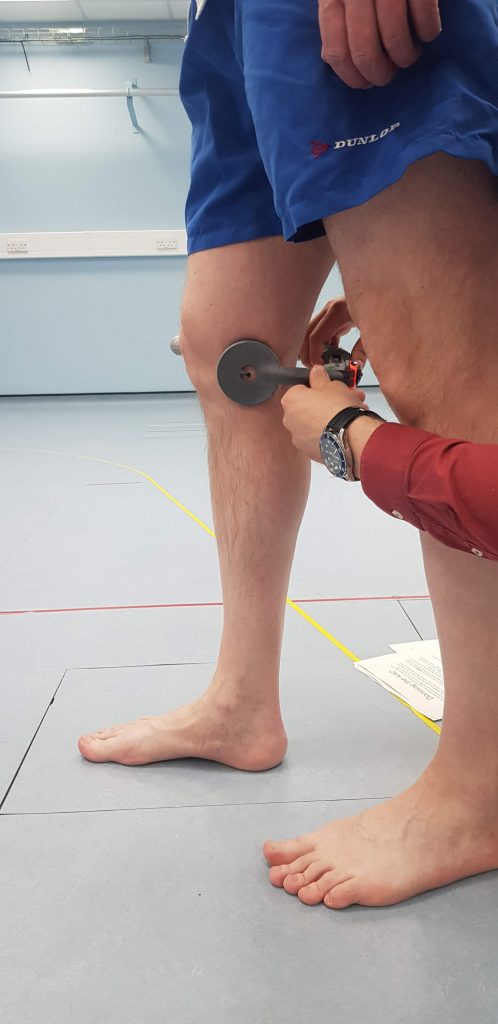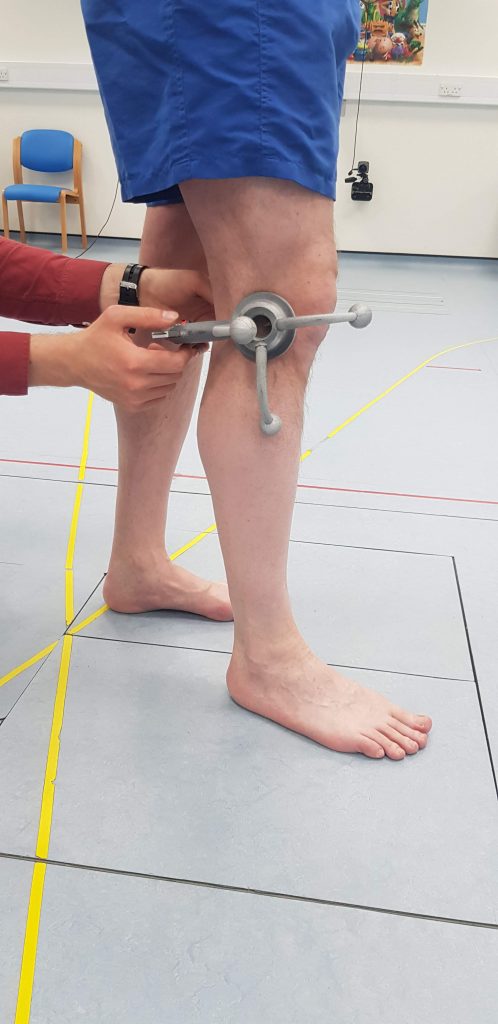Improved design for NHS knee alignment device
Client: Orthotic Research and Locomotor Assessment Unit (ORLAU) at the Robert Jones and Agnes Hunt Orthopaedic


PROBLEM:
Knee Alignment Devices (KADs) are used at the Orthotic Research and Locomotor Assessment Unit (ORLAU) Gait Lab in the diagnosis of patients with mobility difficulties.
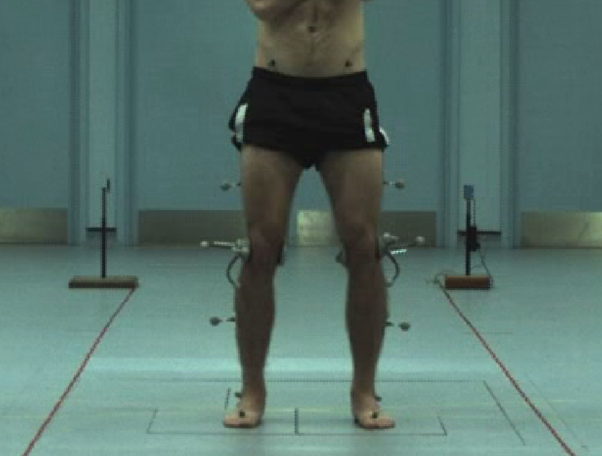
They work by measuring where the patient’s knee bends as a part of measuring gait. First an array of infra-red cameras tracks the reflective markers that are positioned across the patient’s body to create 3D models of the person, which specialists then use to study the movement and decide which rehabilitation treatment is required.
Typically, eight patients a week at ORLAU will require assessment using this tool to analyse movement and decide on a rehabilitation plan.
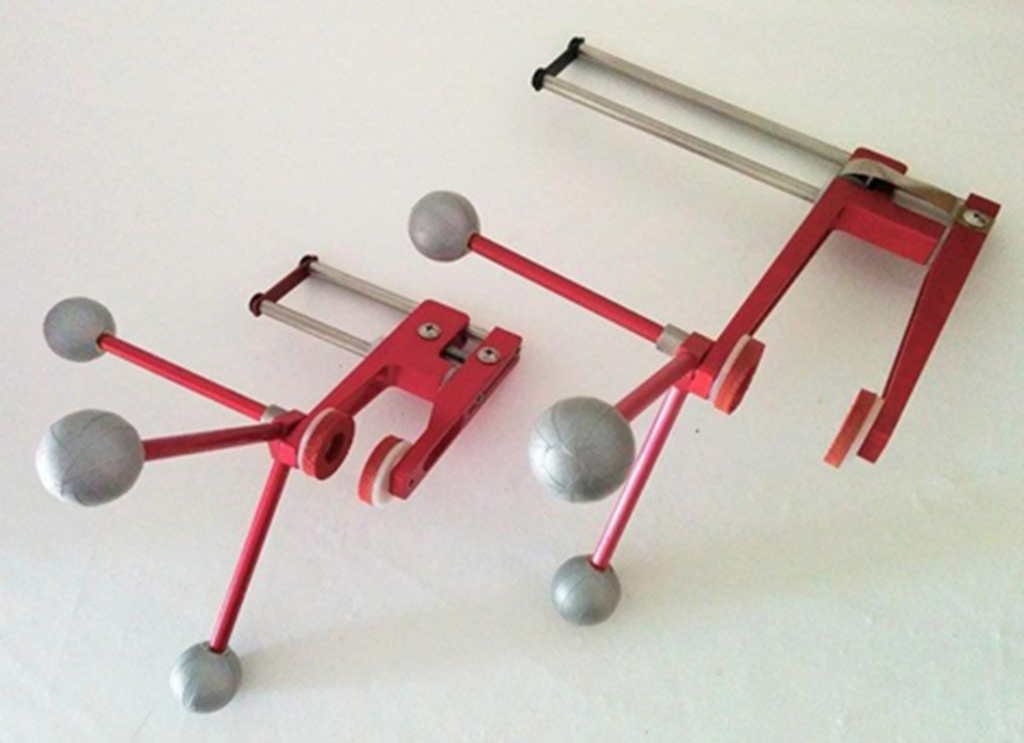
The original KADs ORLAU was working with were old fashioned and had become expensive to source, repair and replace. The springs in the device were prone to breaking and the foam pads provided very little contact with the knee area, so slipped out of position frequently.
Furthermore, many orthopaedic patients struggle to walk or have debilitating conditions such as cerebral palsy, so setting up the original device could be quite uncomfortable and challenging, as it would require the patient to stand too long and therefore cause unnecessary stress.
SOLUTION:
Ricoh 3D had worked with ORLAU previously on the production of an orthotic lever device, so its clinical team was aware of the capability for 3D printing to improve medical tools and create organic shapes suitable for low volume applications. As such, this new part was designed specifically for AM and initially prototyped in FDM, which wasn’t accurate enough for the end-use part, prompting the Rehabilitation Engineering team at ORLAU to reach out to Ricoh 3D as their additive manufacturing partner.
Clinical Scientist Samuel Oliver explained “With the primary focus of the project to increase patient comfort and functionality for clinicians, and ambition was that a new more cost effective KAD would supersede those currently used in our and other gait labs.”
Using the freedom of 3D printing, the team was able to design improved features into the part to refine the ergonomics for the patient and function for the clinical staff. The 3D printed version now has a more ergonomic shape with a cup which fits around the knee, resulting in a larger contact area.
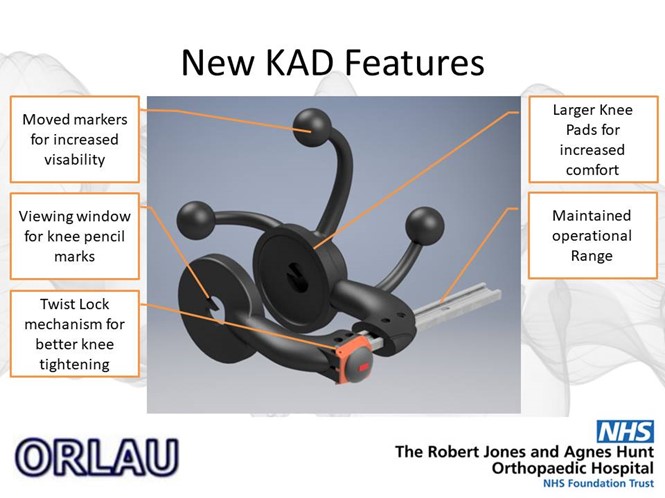
This helps the patient in terms of comfort, but also assists the assessor to set up the patient. Crucially, a new device can be fitted whilst the patient is seated and comfortable, which is particularly helpful for those patients who have trouble standing.
Contact pads were designed to be concave to profile the knee and offer a larger contact area than a flat pad, therefore mimicking the natural shape of the knee. The pad size was also increased to improve the contact area and stability of the device. The original KAD used a ‘clock spring’ system which was expensive and had to be replaced regularly. In the 3D printed version this has been replaced with a standard ‘twist lock’ that is commonly used in cycle shoes and is therefore more readily available.

Inside the part, the Rehabilitation Engineering team designed a reference datum arrow, similar to a crosshair, to allow for accurate placement of the device on a patient. This clever addition guarantees alignment between both knees and greater accuracy, which means fitting is simpler and can be reproduced effectively.
FEA analysis provided confirmation that the proposed design would perform in its intended environment with a robust Factor of Safety built in, ensuring that the markers didn’t deviate too much when tightened to the knee. Load and weight factors were also applied to generate the least amount of material (and therefore cost) possible.

The markers are now fixed, rather than on a moving framework. Assessors at ORLAU have already reported that this is a huge improvement over the old system, which was difficult to set up and to get in place correctly.
Due to the cost sensitivities of the NHS, the Ricoh 3D team recommended the part was printed in MJF Nylon 12, which is a stiff general material that offers cost efficiency, as well as the ability to produce complex geometric detail.

MJF parts exceeded the clinical team’s expectations in terms of accuracy and, therefore, ongoing production was rolled out to this material.
Keith Miller, Rehabilitation Engineer at ORLAU, said: “We’re absolutely delighted with the new KADs.
“The old design was difficult and uncomfortable for the patient and assessor to set up. The reimagined KADs offer an improved patient experience, as well as more accurate diagnosis.
“This is the second time we have teamed up with Ricoh 3D to improve our medical tools. We were once again impressed by the flexible range of technologies and materials available from Ricoh 3D, as well as the design support on offer.
“Ricoh 3D are the ideal manufacturing partner for us and I’m sure 3D printing will find many more solutions for the medical, and especially Rehabilitation Engineering in the years to come.”
